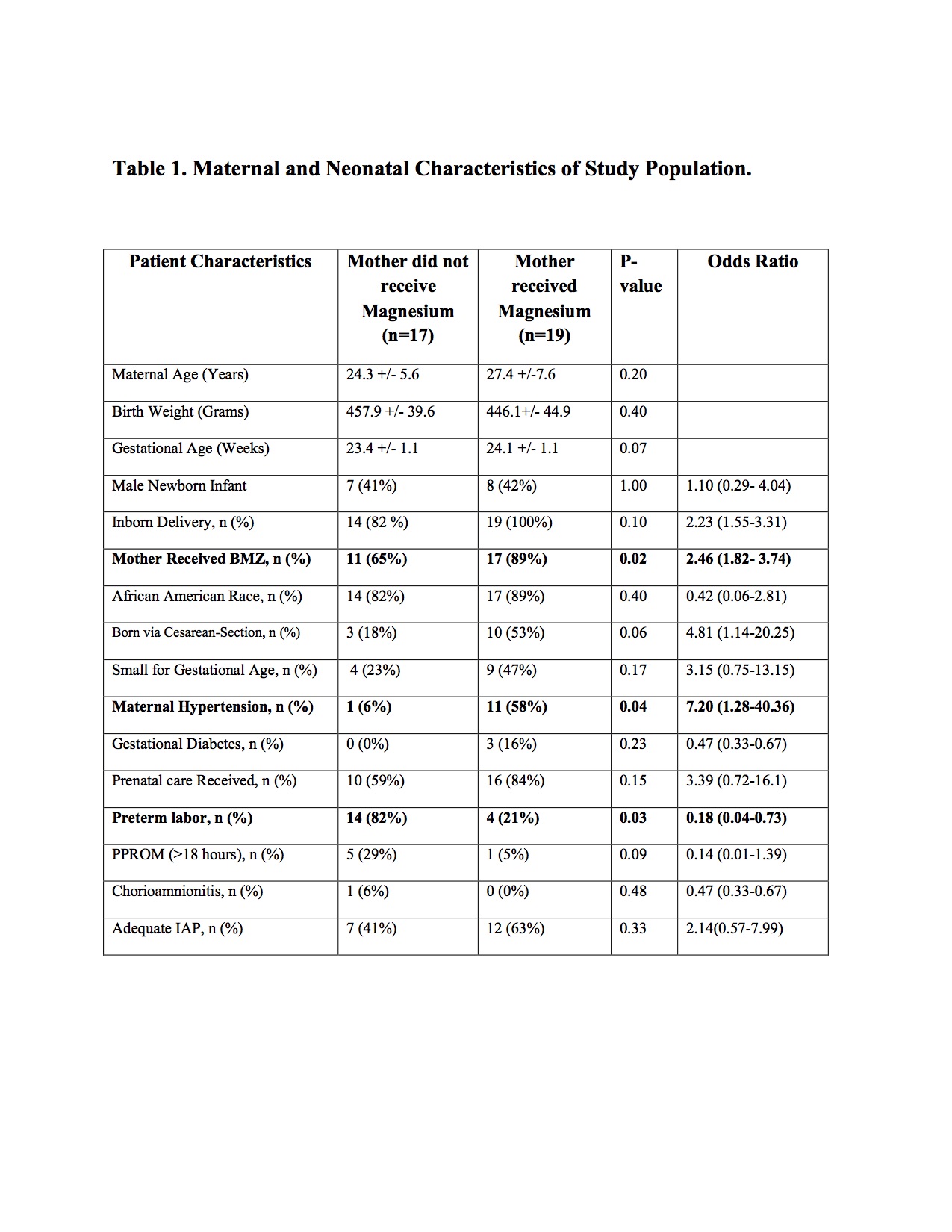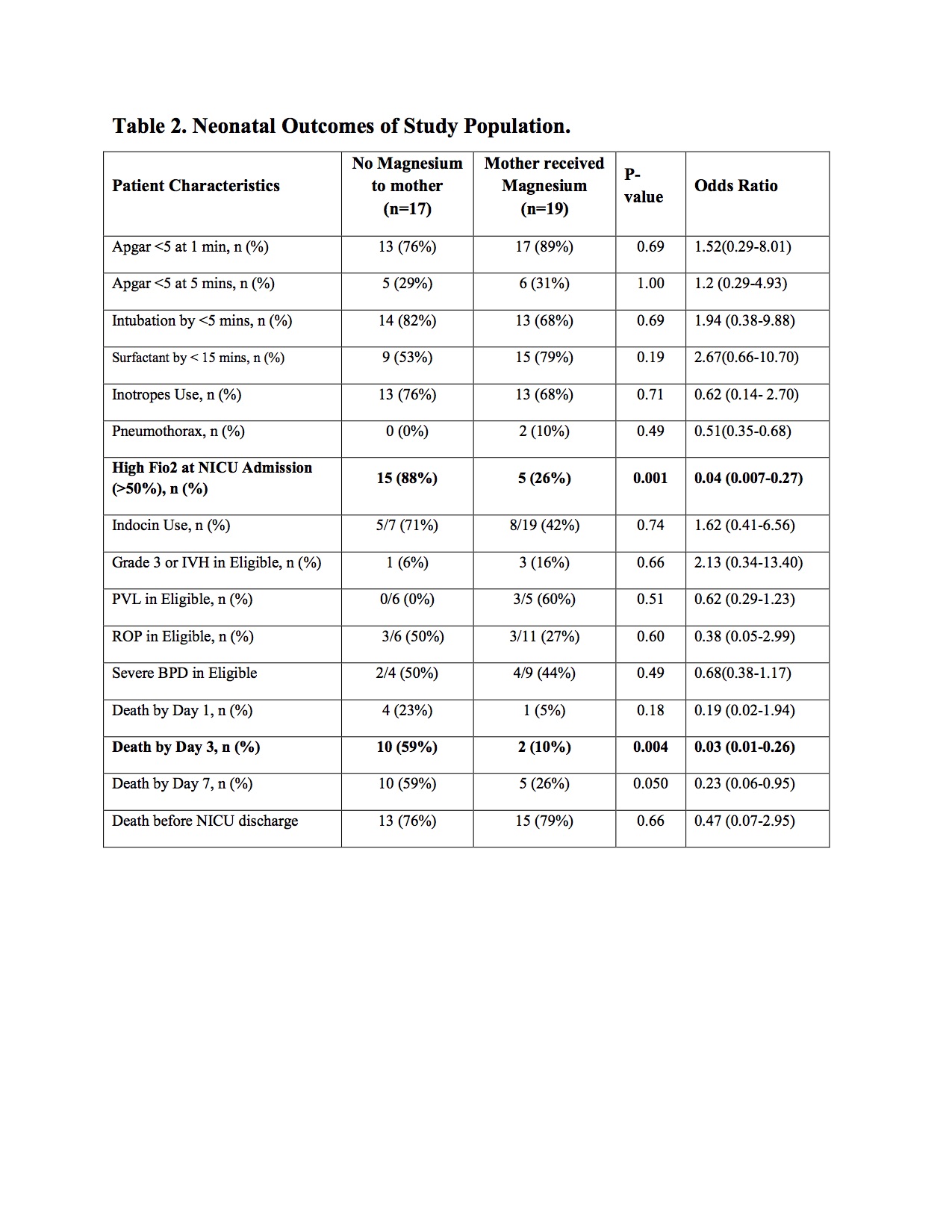Back
Global Neonatal & Children's Health
Category: Abstract Submission
Global Child and Adolescent Health III
523 - Does Maternal Magnesium Therapy benefit Preterm Infants with birth weight less than 500 grams?
Sunday, April 24, 2022
3:30 PM – 6:00 PM US MT
Poster Number: 523
Nita Shrestha, John H Stroger Jr. Hospital of Cook County, Chicago, IL, United States; Vishakha Nanda, JSH, chicago, IL, United States
- NS
Nita Shrestha, MD
Fellow
John H Stroger Jr. Hospital of Cook County
Chicago, Illinois, United States
Presenting Author(s)
Background: Several Randomized Control Trials and meta-analyses have shown benefits of maternal Magnesium therapy prior to preterm delivery. This has shown to reduce the risk of moderate - severe Cerebral Palsy without increasing adverse perinatal outcomes and death in those babies who are born less than 32 weeks of gestational age. The effects of antenatal magnesium therapy on infants with birth weight less than 500 grams however, has not yet been established.
Objective: To compare the effects of maternal Magnesium Sulphate on morbidity and mortality of Extremely Low birth Weight infants weighing less than or equal to 500 grams.
Design/Methods: This is a retrospective cohort study of neonates born between 2008-2021 at an academic tertiary referral center. We included inborn and out born neonates admitted in our Neonatal Intensive Care Unit (NICU) with birth weight less than or equal to 500 grams. Neonates who were offered comfort care, those who died in the delivery room and those with major congenital anomalies were excluded. The differentiating variable was the mother receiving Magnesium Sulfate prior to the delivery. Primary outcome was death during the first week of life or before NICU discharge and the secondary outcomes were severe Intraventricular Hemorrhage (IVH) grade III and above, Periventricular Leukomalacia (PVL), Retinopathy of Prematurity (ROP), Bronchopulmonary Dysplasia (BPD) and Necrotizing enterocolitis (NEC) in the eligible infants. SPSS was used for statistical analysis. Multivariate logistic regression was performed, controlling for potential confounders.
Results: We included 36 newborns, 19 were exposed to maternal Magnesium and 17 were not. The mean Birth weight was comparable in the 2 groups (Table 1). Maternal Magnesium sulphate administration was associated with significant decrease in death in the first 3 days of life in our study population and the exposed newborns had lower Fio2 requirement on NICU admission, even after controlling for Antenatal steroids exposure, preterm labor and gestational hypertension. But this exposure did not change the mortality at hospital discharge or other major co-morbidities of Extreme Preterm birth including Severe IVH, ROP, NEC, PVL or BPD in the eligible infants (Table 2). Conclusion(s): Maternal magnesium sulphate therapy may lead to significant reduction in early Death in the infants with Birth weight less than 500gms. This is one of the few studies done to study the mortality and morbidity in extremely low birth weight babies weighing less or equal to 500 grams.
Table 1. Maternal and Neonatal Characteristics of Study Population. BMZ-Betamethasone; PPROM-Preterm Premature Rupture of Membrane, IAP-Intrapartum Antibiotic Prophylaxis
BMZ-Betamethasone; PPROM-Preterm Premature Rupture of Membrane, IAP-Intrapartum Antibiotic Prophylaxis
Table 2. Neonatal Outcomes of Study Population NICU- Neonatal Intensive Care Unit. P value < 0.05 is significant.
NICU- Neonatal Intensive Care Unit. P value < 0.05 is significant.
Objective: To compare the effects of maternal Magnesium Sulphate on morbidity and mortality of Extremely Low birth Weight infants weighing less than or equal to 500 grams.
Design/Methods: This is a retrospective cohort study of neonates born between 2008-2021 at an academic tertiary referral center. We included inborn and out born neonates admitted in our Neonatal Intensive Care Unit (NICU) with birth weight less than or equal to 500 grams. Neonates who were offered comfort care, those who died in the delivery room and those with major congenital anomalies were excluded. The differentiating variable was the mother receiving Magnesium Sulfate prior to the delivery. Primary outcome was death during the first week of life or before NICU discharge and the secondary outcomes were severe Intraventricular Hemorrhage (IVH) grade III and above, Periventricular Leukomalacia (PVL), Retinopathy of Prematurity (ROP), Bronchopulmonary Dysplasia (BPD) and Necrotizing enterocolitis (NEC) in the eligible infants. SPSS was used for statistical analysis. Multivariate logistic regression was performed, controlling for potential confounders.
Results: We included 36 newborns, 19 were exposed to maternal Magnesium and 17 were not. The mean Birth weight was comparable in the 2 groups (Table 1). Maternal Magnesium sulphate administration was associated with significant decrease in death in the first 3 days of life in our study population and the exposed newborns had lower Fio2 requirement on NICU admission, even after controlling for Antenatal steroids exposure, preterm labor and gestational hypertension. But this exposure did not change the mortality at hospital discharge or other major co-morbidities of Extreme Preterm birth including Severe IVH, ROP, NEC, PVL or BPD in the eligible infants (Table 2). Conclusion(s): Maternal magnesium sulphate therapy may lead to significant reduction in early Death in the infants with Birth weight less than 500gms. This is one of the few studies done to study the mortality and morbidity in extremely low birth weight babies weighing less or equal to 500 grams.
Table 1. Maternal and Neonatal Characteristics of Study Population.
 BMZ-Betamethasone; PPROM-Preterm Premature Rupture of Membrane, IAP-Intrapartum Antibiotic Prophylaxis
BMZ-Betamethasone; PPROM-Preterm Premature Rupture of Membrane, IAP-Intrapartum Antibiotic ProphylaxisTable 2. Neonatal Outcomes of Study Population
 NICU- Neonatal Intensive Care Unit. P value < 0.05 is significant.
NICU- Neonatal Intensive Care Unit. P value < 0.05 is significant.